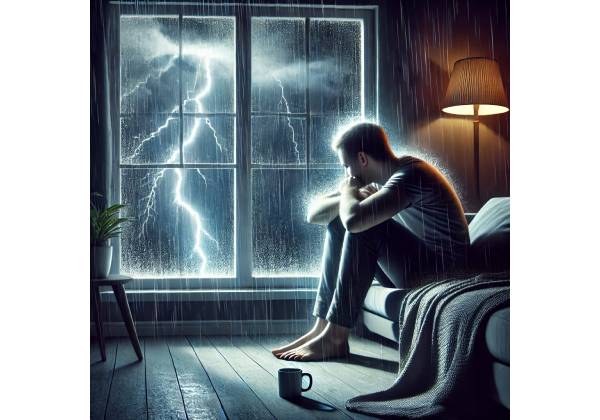What is Astraphobia?
Astraphobia, or the fear of thunder and lightning, is a specific phobia that can cause severe anxiety during thunderstorms. While it is normal for children to be scared during storms, this fear usually fades as they get older. However, for people with astraphobia, the fear lasts into adulthood and can cause significant distress and disruptions in daily life. Astraphobia can be triggered by the sound of thunder, a flash of lightning, or simply the anticipation of a storm.
This phobia can affect people of all ages, including children and adults, and is also seen in pets. The intense fear associated with astraphobia goes beyond normal discomfort, often leading people to avoid situations where storms are likely to occur or to become obsessed with weather forecasts in order to avoid being exposed to them. In some cases, anxiety becomes so severe that it impairs the individual’s ability to function in daily life.
Because weather patterns are unpredictable, people with astraphobia may experience a constant sense of dread, especially during storm seasons. Fortunately, with increased awareness of mental health and anxiety disorders, there are effective treatments available to help people cope with their fear of thunderstorms. Understanding the nature of astraphobia is the first step toward conquering this crippling fear.
What Are The Symptoms of Astraphobia?
Astraphobia manifests as a range of physical, emotional, and behavioral symptoms that can severely disrupt the lives of those who suffer from it. While the severity of these symptoms varies from person to person, many people feel overwhelming fear and panic during storms or even when they anticipate bad weather. Recognizing these symptoms is essential for identifying the condition and seeking appropriate treatment.
Physical Symptoms
When a person with astraphobia encounters or anticipates a thunderstorm, their body may react with the classic “fight or flight” response. Typical physical symptoms include:
- Rapid heartbeat (tachycardia): Anxiety can cause a noticeable increase in heart rate, which can be upsetting in itself.
- Shortness of breath: Breathing becomes shallow or rapid, resulting in a sense of breathlessness or hyperventilation.
- Trembling or shaking: Fear may cause the body to shake uncontrollably, particularly if thunder or lightning strikes nearby.
- Excessive sweating: Increased anxiety can cause excessive sweating in the palms, face, or other areas of the body.
- Chest pain: Anxiety during a storm can cause chest discomfort, which can feel like a heart attack in severe cases.
- Nausea or upset stomach: The fear of thunderstorms can cause digestive issues such as nausea, stomach cramps, or diarrhea.
- Headache or dizziness: Anxiety’s physical stress can result in tension headaches, dizziness, or lightheadedness.
Emotional Symptoms
Emotionally, astraphobia can cause an overwhelming sense of terror that appears out of proportion to the actual threat posed by thunderstorms. Emotional symptoms typically include:
- Panic attacks: Astraphobia can cause panic attacks, which are episodes of intense fear that occur suddenly and unexpectedly. These attacks can cause symptoms such as rapid breathing, racing heartbeat, and a sense of impending doom.
- Overwhelming dread or worry: People with astraphobia may become consumed with worry during storm season, fearing that thunderstorms will strike. This anticipatory anxiety can disrupt daily routines and cause ongoing stress.
- Feeling trapped or powerless: During a storm, people may feel helpless, unable to escape or defend themselves, even if they are indoors and safe.
- Extreme fear of death or injury: In severe cases, people may believe they are in immediate danger of being struck by lightning or killed by a storm, despite being in a safe environment.
Behavioral Symptoms
Astraphobia frequently causes behavioral changes as people try to avoid thunderstorms or cope with their fear. Some common behavioral symptoms are:
- Avoidance of outdoor activities: People who suffer from astraphobia may refuse to go outside if a thunderstorm is expected. This may limit their participation in outdoor activities, sports, or even routine errands.
- Preoccupation with weather forecasts: To avoid thunderstorms, people may obsessively monitor the weather, checking forecasts multiple times a day or seeking reassurance from others about impending storms.
- Seeking shelter in unusual places: When a storm begins, some people may seek refuge in areas they believe are safer, such as basements, closets, or even under furniture.
- Difficulty concentrating or sleeping: The anticipation of thunderstorms can cause restlessness, making it difficult to focus on tasks or get a good night’s sleep, especially if a storm is expected.
Impact on Children
Astraphobia is commonly seen in adults, but it can also affect children. Children may cry, cling to their parents, or refuse to be left alone during a storm. They may hide under blankets or in small, enclosed spaces. As with adults, fear can extend beyond the actual storm to the mere mention or thought of one. This phobia must be addressed early in childhood to avoid persisting into adulthood and causing long-term distress.
Severity and Duration
The severity of symptoms can range from mild discomfort to complete panic. Some people feel mild anxiety during thunderstorms, while others may have full-blown panic attacks. The phobia can be short-lived, developing in response to a particularly traumatic experience, or it can last for years, impairing the individual’s quality of life.
The first step in treating astraphobia is to identify its symptoms. Those who recognize these symptoms in themselves or others should seek help to manage and reduce the phobia’s impact on daily life.
Causes and Risk Factors for Astraphobia
Understanding the underlying causes of astraphobia can help explain why some people experience this fear while others do not. Astraphobia, like many other specific phobias, is believed to be caused by a combination of genetic, environmental, and psychological factors.
Genetic Predisposition
According to research, some people may be genetically predisposed to anxiety disorders, such as astraphobia. If a family member has experienced similar anxiety disorders or phobias, it is more likely that other family members will develop these fears. This genetic vulnerability is related to how the brain processes fear and anxiety, making some people more likely to develop phobias in response to specific stimuli.
Traumatic Experiences
Thunderstorm-related trauma is one of the most common causes of astraphobia. For example, a person who has lived through a particularly severe storm or witnessed lightning damage may develop a strong fear of thunderstorms. These traumatic events can create a long-term association between thunderstorms and danger, resulting in the phobia. Even witnessing a close call, such as a nearby tree being struck by lightning, can instill long-term fear.
Childhood Conditioning
Children who are exposed to thunderstorms at a young age, especially if they are scared or distressed during these events, may develop astraphobia. This phobia can also be acquired through observation. For example, if a child observes a parent or caregiver reacting fearfully to thunderstorms, they may mimic the behavior and internalize the fear themselves.
Cognitive Factors
Astrophobic people may experience cognitive distortions that amplify their fears. These distortions can include catastrophic thinking, in which the individual believes they are in greater danger than they actually are. For example, they may believe they are in high risk of being struck by lightning even when indoors. This irrational fear can exacerbate the phobia and cause anxiety during thunderstorms.
Sensitivity to loud noises
People who are extremely sensitive to loud noises, such as thunder, may be more likely to develop astraphobia. Loud noises can activate the body’s fight-or-flight response, making people feel as if they are in imminent danger. This increased sensitivity can exacerbate anxiety during storms, especially when combined with the unpredictability of thunderclaps.
Comorbid Anxiety Disorders
Astraphobia is frequently associated with other anxiety disorders, including generalized anxiety disorder (GAD) and panic disorder. Individuals who are predisposed to anxiety may find that their fear of thunderstorms worsens their overall anxiety levels, resulting in a more intense phobic reaction. Those suffering from post-traumatic stress disorder (PTSD) may be more likely to develop specific phobias such as astraphobia, especially if the PTSD is linked to traumatic weather experiences.
How Astraphobia is Diagnosed
Astraphobia is diagnosed after a thorough evaluation by a mental health professional, often using the criteria outlined in the **Diagnostic and Statistical Manual of Mental Disorders (DSM-5). To confirm the presence of a specific phobia, this evaluation usually includes interviews, questionnaires, and psychological assessments.
Clinical Interview
The first step in diagnosing astraphobia is a clinical interview in which the patient discusses their symptoms, such as how frequently they are afraid of thunderstorms, the severity of their anxiety, and how it affects their daily life. The clinician will inquire about the patient’s history with thunderstorms and any previous traumatic experiences that may have contributed to the development of the phobia.
Symptom Evaluation
During the diagnostic process, the clinician will determine if the patient’s fear of thunderstorms meets the DSM-5 criteria for a specific phobia. The criteria include:
- Persistent fear: The individual experiences intense and persistent fear or anxiety when confronted with thunderstorms or anticipating them.
- Avoidance: The individual actively avoids situations in which they may encounter thunderstorms.
- Excessive fear: The fear outweighs the actual threat posed by the storm.
- Duration: The symptoms have been present for at least six months.
- Impairment: The phobia significantly disrupts the individual’s daily life, including social, occupational, and academic functioning.
Psychological Questionnaires
Psychological questionnaires are frequently used to conduct a more structured assessment of a person’s symptoms. These standardized tools assist clinicians in determining the severity of the phobia and the level of anxiety related to thunderstorms. Common questionnaires used in diagnosing specific phobias are:
- Fear Survey Schedule (FSS): This survey identifies specific fears, including those associated with natural disasters such as thunderstorms.
- Beck Anxiety Inventory (BAI): This tool assesses the severity of an individual’s anxiety, which can aid in determining the overall impact of the phobia.
These questionnaires are useful for providing a quantitative measure of the intensity of the phobia and its impact on the person’s emotional well-being.
Differential Diagnosis
Clinicians must rule out other mental health conditions that may mimic or exacerbate the symptoms of astraphobia. Individuals with generalized anxiety disorder (GAD) or post-traumatic stress disorder (PTSD) may feel anxious about thunderstorms, but their fear may not be limited to weather phenomena. A thorough differential diagnosis ensures that the treatment plan is appropriate for the individual’s specific needs.
Once astraphobia is diagnosed, the next step is to create a treatment plan that will help the individual reduce their fear and manage their anxiety more effectively.
The Effects of Astraphobia on Daily Life
Astraphobia can have far-reaching consequences, influencing many aspects of a person’s daily life. The unpredictable nature of weather patterns can make this phobia especially difficult to manage, as people may feel on edge even during clear skies, knowing that a storm could form at any time.
Social Impact
Individuals who are afraid of thunderstorms may avoid participating in social activities that could expose them to bad weather. For example, someone with astraphobia may avoid outdoor gatherings, parties, or events such as camping or hiking trips that could put them in danger of encountering a storm. This avoidance can result in feelings of isolation and social withdrawal because the individual misses out on important social interactions and life experiences.
Professional consequences
Astraphobia can also affect a person’s professional life. Individuals who work outdoors or in environments where weather is critical may be unable to fulfill their job responsibilities due to their fear of thunderstorms. Even office workers may experience increased anxiety when they hear a storm approaching, reducing productivity and concentration. Furthermore, constant concern about potential storms can lead to absenteeism or an inability to concentrate at work.
Emotional and psychological strain
Astraphobia can have a severe emotional impact. Individuals frequently feel a constant sense of dread during storm seasons, which can lead to chronic stress. This persistent anxiety can make it difficult to relax or enjoy activities, even on sunny days, because the threat of a thunderstorm looms in the background. Over time, this increased anxiety may contribute to depression, especially if the person believes that their phobia is limiting their ability to live a fulfilling life.
Impact on Children
Astraphobia in children can cause disruptions in school and family life. A child who is afraid of thunderstorms may refuse to attend school if bad weather is predicted, resulting in missed days and falling behind academically. During storms, parents may find it difficult to comfort their child at home, especially if the child’s anxiety becomes severe.
Sleep Disruptions
People with astraphobia frequently have disrupted sleep, especially if thunderstorms are predicted for the night. Anxiety about the possibility of a storm can make it difficult to sleep or cause frequent awakenings during the night. Sleep deprivation can exacerbate feelings of anxiety and irritability, creating a difficult to break cycle.
Top Treatment Options for Astraphobia
Astraphobia treatment is frequently very effective, and many people see significant improvements after a combination of therapeutic interventions. The goal of treatment is to reduce the individual’s fear of thunderstorms while also providing them with coping strategies to manage their anxiety. The most effective treatment plans are tailored to the severity of the phobia and the individual’s specific needs.
Cognitive-Behavioral Therapy (CBT)
Cognitive Behavioral Therapy (CBT) is one of the most popular and effective treatments for specific phobias, such as astraphobia. CBT aims to help people identify and challenge irrational thoughts that contribute to their fear of thunderstorms. This therapy helps patients understand that, while thunderstorms can be dangerous in extreme circumstances, they are generally not a threat when precautions are taken.
During CBT sessions, therapists work with clients to gradually confront their fears in a controlled and safe setting. This process, known as exposure therapy, allows patients to experience their fear in manageable doses, reducing their anxiety over time. Astraphobia exposure therapy may include listening to thunderstorm recordings, watching storm videos, or, in later stages, experiencing a storm from a safe location. The gradual exposure helps the individual become desensitized to the fear, making thunderstorms less frightening over time.
CBT also teaches patients how to manage their anxiety using relaxation techniques and cognitive restructuring. Individuals can learn to react more calmly and rationally to storms by changing their perspective on them.
Mindfulness and Relaxation Techniques
Mindfulness-based therapies and relaxation techniques are frequently used to treat astraphobia. These techniques assist individuals in remaining present in the moment and preventing their fear from escalating into panic. For example:
- Deep breathing exercises can help calm the nervous system during a storm, reducing symptoms such as racing heartbeat and shortness of breath.
- Progressive muscle relaxation (PMR) teaches people to release tension in their bodies one muscle group at a time, which can be especially beneficial during times of high anxiety.
- Mindfulness meditation encourages people to concentrate on their immediate surroundings rather than allowing their minds to wander into catastrophic thoughts about the storm.
These techniques are especially useful during thunderstorms, when people may otherwise become overwhelmed by their fear.
Exposure Therapy
Exposure therapy, a key component of CBT, is one of the most effective methods for treating phobias such as astraphobia. The gradual exposure to thunderstorms allows people to confront their fear in a safe and controlled environment, ultimately lowering the intensity of their anxiety. There are a few approaches to exposure therapy:
- In vivo exposure: This refers to direct exposure to real-life thunderstorms. Individuals who work with a therapist learn to remain calm during a storm, breaking the link between storms and extreme fear.
- Imaginal exposure: For those who find real-life exposure too overwhelming at first, imaginal exposure can be a useful starting point. This approach involves the individual imagining themselves in a storm and practicing managing their anxiety in response to these mental images.
- Virtual reality (VR) exposure: Some therapists use virtual reality technology to simulate thunderstorms in a controlled environment, allowing patients to practice coping strategies before they encounter a real storm.
Medication
In some cases, medication may be prescribed to help manage astraphobia symptoms, especially if the anxiety is severe and interferes with daily activities. Commonly prescribed medications include:
- Selective serotonin reuptake inhibitors (SSRIs): These medications, such as fluoxetine or sertraline, are frequently used to treat anxiety disorders and can help reduce overall anxiety levels in people suffering from astraphobia.
- Benzodiazepines: These medications, such as lorazepam or diazepam, are occasionally used for short-term relief of severe anxiety during thunderstorms. However, they are not recommended for long-term use due to the risk of dependence.
- Beta-blockers: Beta-blockers may be prescribed in some cases to help manage physical symptoms of anxiety, such as trembling or racing heartbeat, during thunderstorms.
While medication can help manage symptoms, it is usually used in tandem with therapy to provide long-term relief from astraphobia.
Support Groups and Counseling
Individuals can benefit from support groups because they provide a safe environment for them to share their experiences and learn from others who are facing similar challenges. Group therapy or online communities for anxiety and phobias can provide emotional support as well as practical advice for dealing with fear during thunderstorms.
Individual counseling can also be beneficial, particularly for those with phobias that are deeply rooted in past trauma. Working with a therapist to identify the underlying causes of a phobia can help people better understand their fear and develop healthier coping mechanisms.
Lifestyle Modifications
Making certain lifestyle changes can also help with the treatment of astraphobia. These changes can help reduce overall anxiety levels and improve resilience during thunderstorms.
- Limiting caffeine intake: Caffeine can increase feelings of anxiety, so reducing consumption may help people feel more calm during storms.
- Regular exercise: Physical activity is a natural stress reliever that can gradually reduce anxiety levels.
- Maintaining a healthy sleep routine: Getting enough sleep can improve emotional regulation and reduce the severity of anxiety responses.

















